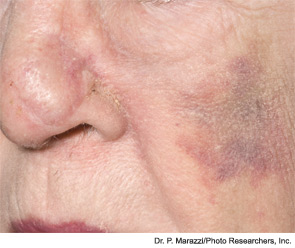
Explore This Issue
February 2012MIAMI BEACH — The right way to restore a patient’s nose after cancer depends on subtle factors: The shape, the depth, and the precise location of the wound all dictate how to go about the reconstruction, experts said here on Feb. 1 at the Triological Society Combined Sections Meeting.
Local Flaps
William Shockley, MD, chief of facial plastic and reconstructive surgery at the University of North Carolina School of Medicine, said the advantages of a full-thickness skin graft over using a local flap for a nasal defect are that there are no additional facial scars, they can be easily trimmed to fit the shape and there are fewer issues with dogears and pincushion deformities. The drawbacks are that the viability is not as certain, the thickness of the graft can’t be adjusted much and there’s no opportunity for adding structural integrity from cartilage.
His technique involves making the corners of the local flap an angle, turning a circle into a square and an oval into a rectangle, and “gentle” debridement of the wound bed. “You want to debride enough to instigate bleeding, but, especially over by the ala, you really don’t want to excise a significant amount of tissue because sometimes that will actually cause further collapse,” he said.
He said he wishes he did more grafts after allowing granuation tissue to develop, thinking he’d get better results, but the procedure requires a delay after Mohs micrographic surgery, and patients often do not want to wait.
“My patients are all geared up,” he said. “Talking them into waiting another week to 10 days is not really what they’re looking for.”
Bilobed Flaps
John Rhee, MD, MPH, professor and chairman of otolaryngology and communication sciences at the Medical College of Wisconsin, talked about the merits of bilobed flaps, in which two rounded “lobes” are carved out of the nose and then moved toward the defect. One lobe covers the defect and the second lobe covers the defect created by the other lobe.
Dr. Rhee said there are certain advantages to using this kind of flap, also called a “transposition flap,” rather than a rotation flap, in which a larger section of skin is shifted from one area into another. “It’s less likely to cause retraction when used in sensitive areas such as the alar rim or nasal soft tissue triangle,” he said.
Leave a Reply